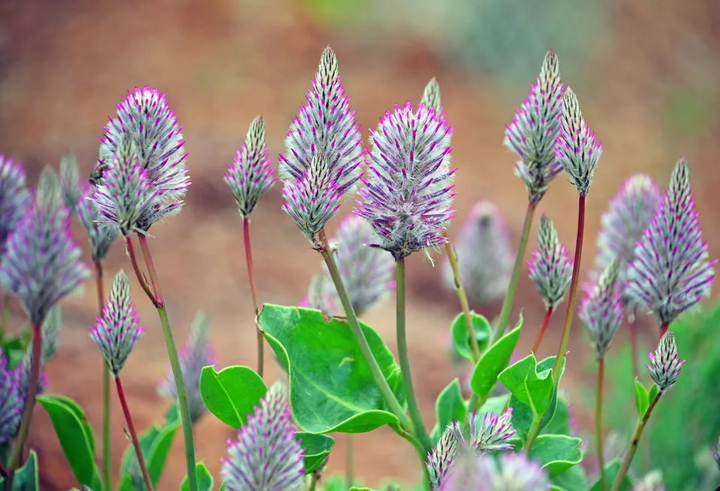A more recent addition to the horticultural scene in North America, the ptilotus plant (ptilotus exaltatus) is known for its unique and spectacular spires of fat, feathery bottlebrush-shaped flowers in a lovely silver-pink color.
This cone-like plant, known by the common name of Pink Mulla Mulla, is one of the biggest and rarest of over one hundred species within the overarching ptilotus genus.
These plants have an ornamental silver-green foliage that's thick and fleshy. Its soft plumes are about four inches tall and drape gracefully over the leathery foliage.

Native to the dry, arid plains of Australia, the long-lasting blooms of the ptilotus appear soft and fuzzy, but they feel quite hard and bristly to the touch. Due to their texture, the blooms manage to hold up quite well in various weather conditions. They are similar in appearance to the celosia, and both are members of the Amaranthaceae family.
This herbaceous perennial is often grown as an annual. It serves an accent plant that is often grown in a container as a specimen, as well as part of a larger group of similar blossoms to create a truly eye-catching display. They can add a soft, cottage-garden look to your yard, and they are also often cut and dried for arrangements.
Botanical Name:
Ptilotus exaltatus
Common Name:
Pink Mulla Mulla, Tall Mulla Mulla
Plant Type:
Annual/Perennial
Mature Size:
1-3 feet
Sun Exposure:
Full sun
Soil Type:
Well-drained
Soil pH:
5.5-6.5
Bloom Time:
Spring/Summer/Fall
Flower Color:
Pink
Hardiness Zones:
2-11
Native Area:
Australia
Ptilotus Plant Care
An upright-growing plant, the ptilotus exaltatus will thrive when planted in a location that's bathed in sunlight (provided the soil is well-drained). They are often planted in the middle or back of a border, where the ptilotus can contrast beautifully with annual flowers.
These sun-loving, drought-tolerant plants are easy to grow and can be pretty much be ignored once they're established.
Gardeners should know that these plants are susceptible to root rot. In order to prevent this often fatal issue, a product designed to fight fungal pathogens within the soil can be used. If your plant was in a pot that already held soil contaminated with root rot fungus, the pot should be bleached before reusing in order to kill off any remaining spores.
Light
The ptilotus plant requires full sun to survive. It should receive at least six to eight hours of direct sun for the best growth.
Water
These are truly drought-tolerant plants. The ptilotus will rarely require watering, with the exception of severe drought-like conditions.
Soil
The ptilotus plant will grow best in well-drained, lean and loose soil (it can also be sandy). This should be amended to the ideal growing conditions with organic matter before planting.
Temperature and Humidity
These warm-weather plants are perfect for anyone who lives in a hot, dry climate, and they are often grown in the Mediterranean, tropic or subtropical desert, or in temperate climates. Protection from heavy frost is crucial, especially for younger ptilotus plants.
Fertilizer
The ptilous exaltatus is considered to be a fairly low-maintenance plant and doesn't necessarily need any additional fertilization (provided it was planted in average- to-good-quality soil in the first place). However, a general-purpose fertilizer can be used to encourage faster growth.
Propagating Ptilotus
The ptilotus exaltatus can generally be propagated via seed. Its prolific flowering habit and early transition from vegetative to reproductive growth sometimes makes it difficult to successfully propagate this plant by cuttings. However, it can be done--just be sure you're attempting to propagate in the warmest part of the year, preferably with the highest humidity.
Other Ptilotus Varieties
Of all the Ptilotus varieties, the exaltatus is known for being rarer, taller and slightly more difficult to grow. Some of the other varieties include:
Ptilous nobilis: Known for its soft, flowing flowers
Ptilous manglesii: Attractive rose-color tipped flowers
Ptilous spathulatus: Often used as a groundcover
Pruning
The flowers on a ptilotus exaltatus can tend to appear ragged as the plant gets older. This problem can be addressed by deadheading any spent, faded blossoms to encourage new growth and make your plant appear more attractive.
Growing in Containers
The ptiolotus plant can also be grown in containers filled with well-drained soil. You'll just want to be sure the soil dries out completely between each watering.
Since the ptilotus tends to grow large (and can almost appear weed-like) in its natural environment, more compact varieties have been developed that can be used for planting in both containers and gardens.